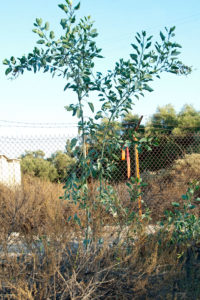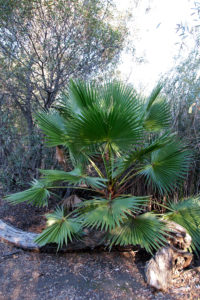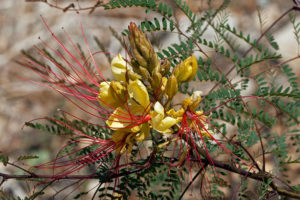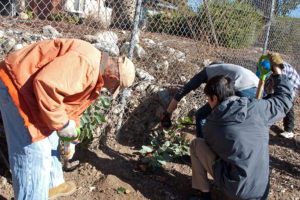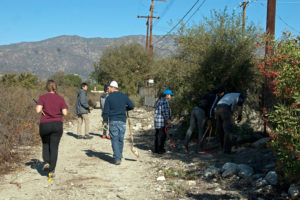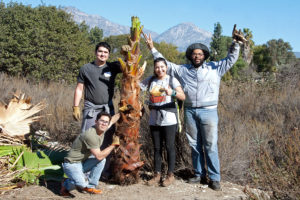For the last workday of the fall semester, volunteers removed a number of invasive woody plants, including:
- Tree Tobacco (Nicotiana glauca)
This South American native was introduced to California about 100 years as a landscape plant. It produces the poisonous alkaloid anabasine and is very toxic to both humans and wildlife.
Tree Tobacco is drought resistant, tolerates a wide range of conditions, and grows rapidly to form dense stands that displace native vegetation.
At the BFS, Tree Tobacco plants are currently mostly along the fire roads and other disturbed areas, but we want to remove them before they spread.
- Mexican Fan Palm (Washingtonia robusta)
Mexican fan palms are native to central Mexico, but were introduced into the Los Angeles area as a ornamental, where they became iconic Los Angeles street trees. In the 1930s alone 40,000 Mexican Fan Palms were planted along 150 miles of streets in Los Angeles.
Mexican Fan Palms reproduce by seed, which can be dispersed by droppings from bird that eat the palm fruits or spread by water along washes, streams, and storm drains. Mexican Fan Palms are especially invasive in riparian areas, where the palms can form monospecific stands that threaten biodiversity. The dead palm fronds can also pose a fire hazard.
At the BFS, a number of these Mexican Fan Palms popped up around pHake Lake.
- Bird-of-Paradise Shrub
(Caesalpinia gilliesii)The Bird-of-Paradise Shrub is native to Argentina and Uruguay, but has been widely planted around the world for its beautiful flowers. It tolerates dry conditions and invaded arid areas of the American southwest as well as South Africa, displacing native vegetation.
At the BFS, seeds from plants in adjacent yards have been carried across the fire road, and new Bird-of-Paradise shrubs have started cropping up in the sage scrub, where we want to remove them while they’re still small.
The workday was very successful, and the volunteers removed every one of the Mexican Fan Palms, Tree Tobaccos, and Bird-of-Paradise shrubs that we have located. They also removed a few young Mexcian Palo Verde Trees and some horehound for good measure. Here are some photos of the volunteers at work:
The next workday is scheduled for January 21 February 4 – we hope you can join us then!
